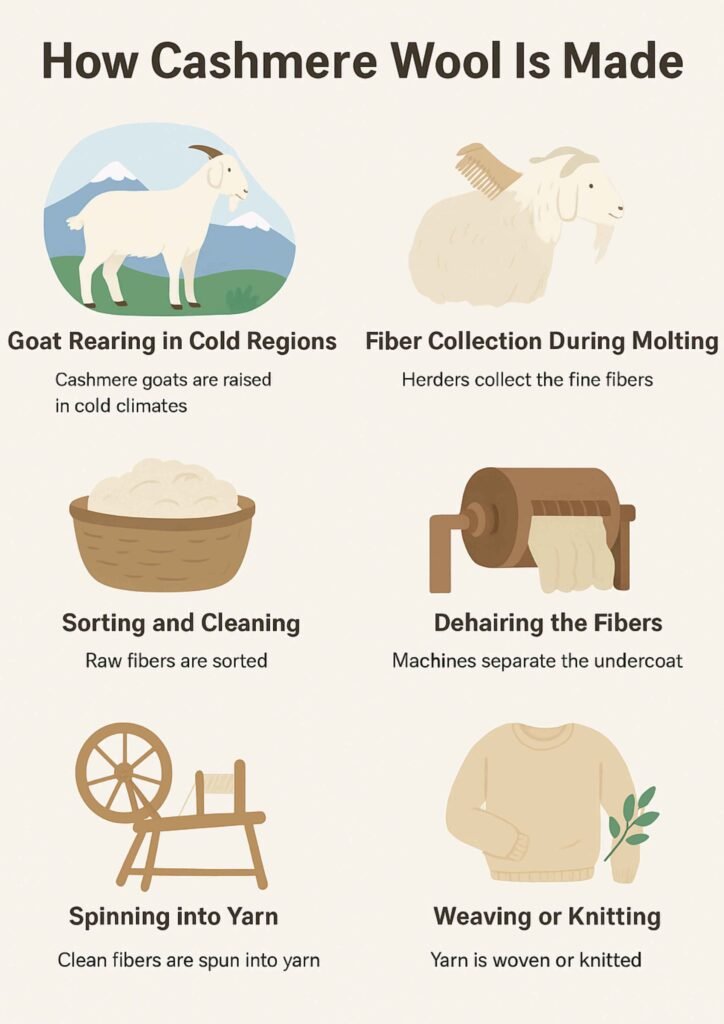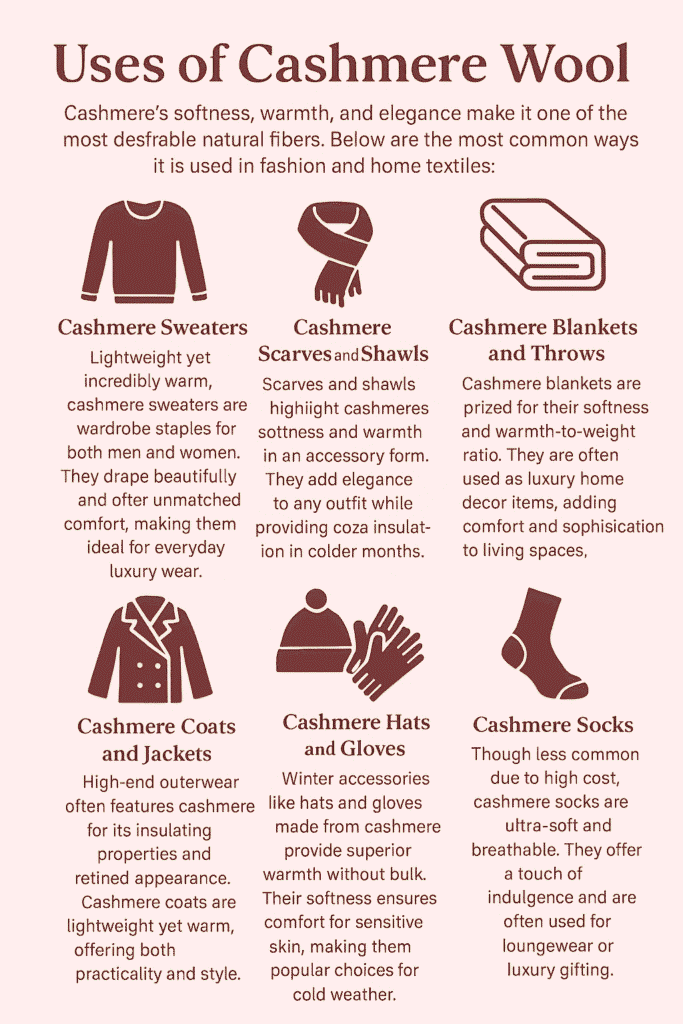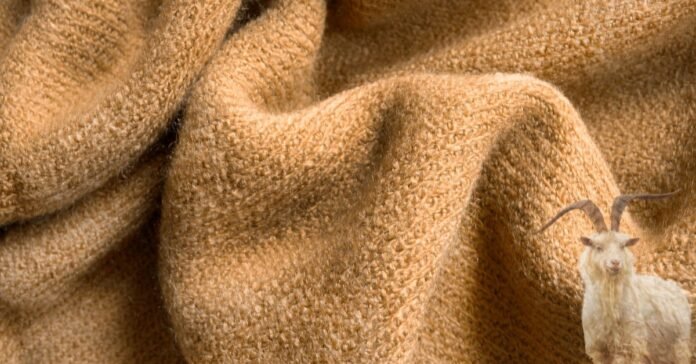Introduction-
Cashmere is a natural fabric that is considered to be the softest and most luxurious in the world. This fiber was renowned and is famous because it is unsurpassed in its warmth, lightness, and elegance. But what does cashmere wool consist of? The solution is the fine undercoat of special goats that grow in cold hilly areas. Maybe a little softer than the wool of the sheep, this fine fiber is carefully gathered and treated, to produce sweaters, scarves, and other classic luxury products.
Understanding Cashmere Wool
Definition of Cashmere
Cashmere wool refers to a fine natural fibre that is derived out of cashmere goats. It is the undercoat that grows in the winter and insulates sheep in order to protect them against cold, unlike the normal wool of the sheep. Its fineness is 14 to 19 microns on average and makes it much softer than usual wool. A premium fabric offered by fashion houses is cashmere since it is not heavy and it feels silky on the skin yet it keeps one warm.
Origins of Cashmere
Cashmere can be traced back in centuries to the place of origin, Kashmir in India to give it its name. The largest producers are now Mongolia, China, Nepal and some parts of Iran. In the past, cashmere shawls were the symbols of nobility and power among rulers and nobles in Europe and Asia. This tradition makes it gain a name of being a strand of royalty and refinement.
What Is Cashmere Wool Made From?
Cashmere wool is created out of the undercoat of cashmere goats particularly those in extreme climates. These goats develop a thick fine layer of down underneath the outer guard hairs. Herders gather fibers during spring when goats shed the coat in nature. The cashmere is soft because the undercoat fibers are incredibly thin sometimes in the range of 1419 microns in diameter. The Changthangi in India, Hircus in Mongolia, and Tibetan goat are breeds that bear high quality cashmere.
How Cashmere Wool Is Made? Step-by-Step Process

Goat Rearing in Cold Regions
Raising of cashmere goats is done in cold climates like in Mongolia, China, Nepal and Kashmir. These areas stimulate the growth of goats with a soft inner layer to serve as a source of warmth in the cold winter.
Fiber Collection During Molting
Goats shedding happen naturally in spring. The fine fibers are gathered by herders, commonly through mild combing. By doing so, the animal does not get 2 harmed, and the method guarantees long, soft fibers.
Sorting and Cleaning
When the raw fibers are collected, they are sorted, according to quality, length and color. These are then sprayed (scoured) to get the grease, dirt and impurities out.
Dehairing the Fibers
The soft undercoat is parted off the coarse guard hairs by special machines. This is necessary to make the high quality cashmere with a silky touch.
Spinning into Yarn
The fibers having been cleaned and depilitated are carded, combed and spun to fine yarn. The yarn can be kept in its natural form or dyed at this point based on the product required.
Weaving or Knitting
The yarn is then either woven or knitted into fabrics. Proficient craftsmen or machines transform it into sweaters, scarfs, shawls and blankets.
Finishing Touches
Lastly, the cloth or garment is laundered, made soft and moulded. This adds the luxurious look and feel of the cashmere that it is known to have.
What Makes Cashmere So Special?
Fiber Structure and Softness.
The cashmere is so soft because it has ultra-fine fiber structure. Cashmere being softer than the wool of the sheep with a count of up to 14 microns compared to a range of 20 to 40 microns. This thin structure enables the fiber to be silky and at the same time lightweight.
Durability and Insulation Properties.
Cashmere is very insulating yet it is light. The hollow fibers trap heat making it warm up to eight times more than the wool of sheep. Simultaneously, it is breathable, thus, comfortable in cold or mild climates. This fact of coziness and easy feel helps cashmere to be a luxury in itself.
Types and Grades of Cashmere Wool
Pure vs. Blended Cashmere
Pure cashmere is prepared using goat undercoat fibers fully and other fibers such as silk, cotton or wool are mixed to make blended cashmere. Blends reduce the prices and still deliver softness and warm feel, which is cheaper to use daily.
Cashmere Grades (A, B, C)
The grades of cashmere known are A, B and C. Grade A is the best with fibers measuring as thin as 14 microns. The softest and most expensive is the type. Grade B fibers are a little bit thicker and Grade C at approximately 30 microns is coarser and less expensive.
Pashmina vs. Cashmere
The name of pashmina originated in Persian meaning pashm; soft gold. Pashmina is a fine undercoat of Changthangi goats in Kashmir and Ladakh that is woven into true pashmina. Although technically, pashmina is a form of cashmere, a lot of items sold as such are blends and thus buyers need to verify authenticity.
Cashmere vs. Other Wools
Sheep’s Wool vs. Cashmere
Cashmere is significantly finer than wool of a sheep and that generally has a diameter of 20- 40 micron. This contrast causes cashmere to be a lot softer and warmer on the skin. Wool of sheep is tougher and cheaper and can be used on heavy-duty clothes. Nonetheless, it is not able to compete with the lightweight luxury and sleekness that cashmere delivers.
Cashmere vs. Merino Wool
Merino wool is regarded as one of the soothing sheep wools with fibers at about 17-25 microns. Although merino is warm and great as an active wear, it remains rougher than cashmere. Cashmere is warmer when compared to the same weight and is smoother in appearance, so more luxurious. However, Merino is both more robust and simpler to take care of, so it is a viable alternative.
Cashmere vs. Alpaca Wool
Another luxury fiber is alpaca wool that is valued because of its warmth and softness, and the fibers normally measure 18 – 25 microns. It is firmer and sturdier compared to cashmere hence it does not pill up easily with time. Cashmere is finer, though, and lighter and is smoother on the skin. Both are high-end product choices, yet cashmere is more demanded due to its unrivaled softness.
Uses of Cashmere Wool
The softness, warmth and elegance of cashmere make it one of the most desirable natural fiber. In fashion and home textiles it is most frequently used in the following forms:

Cashmere Sweaters
Cashmere sweaters are light but incredibly warm and this makes them the favorite wardrobe of both men and women. They are gorgeous and provide unsurpassed comfort, hence can be considered as everyday luxury attire.
Cashmere Scarves and Shawls
In an accessory form, cashmere is soft and warm and is accentuated by scarfs and shawls. They are very classy to any dress and give a warm insulation during colder days.
Cashmere Throws and Blankets
Cashmere blankets are valued on the basis of softness and warmth to weight ratio. They find application as luxury furniture decorations which help provide comfort and elegance to the living rooms.
Coats and Jackets of Cashmere
Expensive outerwear has frequently used cashmere because it is an insulator and has an elegant look. Cashmere coats are easy to wear, but are warm and are practical and stylish.
Cashmere Hats and Gloves
Gloves and hats crafted with cashmere are warmer but will not make them heavy. They are comfortable in cold weather, being soft so that sensitive skin can be comfortable.
Cashmere Socks
Cashmere socks are not very popular because it is very expensive but ultra-soft and breathable. They provide a hint of luxury and can be worn as lounge, or as a luxury gift.
Ethical and Environmental Considerations
Sustainability of Cashmere
Although cashmere is natural, large scale production presents a problem. The situation in Mongolia has resulted in desertification caused by overgrazing by goats which has damaged delicate grasslands. Climate change also impacts on the areas of goat herding and this brings about sustainability issues.
Ethical Sourcing
Consumers are becoming more and more conscious of ethically sourced cashmere. Better environment and animal welfare practices are guaranteed by such certification as The Good Cashmere Standard or Sustainable Fibre Alliance. Ethical herding is a way of making sure goats are not mistreated and grazing fields aren’t ruined.
How to Identify Real Cashmere vs. Fake
True cashmere is costly because it is rare. Customers need to look at labels. Authentic cashmere will usually be certified or well labelled. The price can also indicate it- very cheap products are generally blends or synthetics. And a touch test may be done at home: the touch of real cashmere is soft and warm. Authenticity can also be determined in a burn test since real fibers will burn and smell like burnt hair, whereas synthetic fibers will burn and smell of plastic.
Caring for Cashmere Wool
Washing Tips
Cashmere is to be hand-washed in light detergent or dry-cleaned. Violent detergents destroy the fine fibers, whereas hot water may shorten the garment. Light treatment keeps softness and form.
Storage Tips
Fold clothes rather than hang in order not to stretch them when storing cashmere. Lavender sachets or cedar blocks should be used to stop the moth damage. Keep in breathable bags to keep the fiber long lasting and fresh.
History and Cultural Significance of Cashmere
Cashmere has a rich history as it can be said to have initially started in the Kashmir area of India where master craftsmen initially learned to spin the fines fibers into fluffy shawls. These shawls were very precious and gained the status of a symbol of prosperity, luxury and nobility in Asia and Europe over centuries. In the 18 th and 19 th centuries, the European elites imported Kashmiri cashmere, which became a must-have luxurious fabric. It was also a cultural treasure because of its softness, rarity, and complex weaving methods which indicated craftsmanship and beauties. Even nowadays, cashmere still has its heritage of luxury, connecting centuries of tradition with the luxury fashion of the modern time.
Conclusion-
What is cashmere made of? It is woven using the fine undercoat of the cashmere goats, more so in the cold areas. Its fine fibers of about 14-19 microns render it softer and warmer than normal wool. The rare fiber is hard to gather and expensive to process and thus is worthwhile and luxurious. Through its well-kept maintenance, cashmere will always be a classic investment that can be worn as a reminder of tradition, elegant looks, and coziness- the cloth of luxury.
Read More>> About an artificial fabric blizzard fleece.
FAQs
Cashmere is a form of soft wool of cashmere goats. These goats inhabit chilly areas in which they grow fine insulating fibers. Their natural molting season is the time the undercoat is gathered.
Cashmere is precious and it is a work intensive job because each goat can produce very little per year. There is also the sorting, dehairing and spinning of the fiber, which increases expenses. It has no equivalent softness and warmth that increases its luxury value.
Cashmere is cruelty-free when it is sourced in a humane way since it is harvested during the natural shedding. Conscientious herders do not shear animals, but use combing to ensure the comfort of animals. The certifications will be used to ensure the best welfare standards of animals.
Cashmere is only of goats not sheep. Sheep reproduce normal wool that is coarse and thick. Cashmere goats produce a special undercoat which is more fine and soft.
So what is the distinction between cashmere and pashmina?
Pashmina is a fine cashmere wool that is obtained in Changthangi goats in Kashmir and Ladakh. Although all pashmina is cashmere, not everything that is cashmere qualifies as pashmina. Pashmina is most commonly handspun and handwoven to shawls.

You actually make it seem so easy with your presentation but I find
this matter to be really something that I think I would never
understand. It seems too complicated and extremely broad
for me. I’m looking forward for your next post, I will try to get the
hang of it!
IBlog comment creation really like how you broke down the step-by-step process of how cashmere is made—it helps explain why it’s considered such a luxury fiber. One thing I’ve always found interesting is how much the quality of cashmere depends on the specific region and climate where the goats are raised, since colder environments tend to produce finer fibers. It would be fascinating to see more discussion on how sustainability efforts are evolving in the industry, given the environmental challenges tied to cashmere production.
I have learn several just right stuff here. Certainly value bookmarking for revisiting.
I surprise how much attempt you place to create such a fantastic informative site.